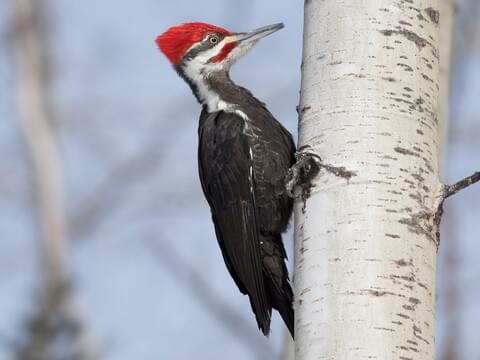Woodpeckers in Florida: Natural History, Ecology, and Conservation
Wiki Article
Discover the Remarkable Globe of Woodpeckers: Everything You Required to Know
The globe of woodpeckers is a realm loaded with special behaviors, intricate adjustments, and a diverse selection of species. From their environments and distribution patterns to their feeding habits and specialized physiological features, woodpeckers have actually long mesmerized the passion of ornithologists and nature fanatics alike. Comprehending the intricacies of these interesting birds offers a glance into the intricate interaction in between their biology and the environment. As we discover the world of woodpeckers further, we reveal a wealth of information that drops light on their relevance in environments and the challenges they deal with in an ever-changing world.Woodpecker Habitats and Circulation
In North America, for instance, woodpeckers can be found in both coniferous and deciduous forests, using their solid beaks to forage for insects and create nesting dental caries in trees. In Africa, specific woodpecker types have actually adjusted to arid environments, such as the acacia timberlands, where they play a vital function in controlling insect populations.
Feeding Behaviors and Diet Plan
Among the different aspects of their actions, woodpeckers display unique feeding behaviors and nutritional preferences. These birds are mainly insectivores, with a diet regimen that consists of ants, beetles, caterpillars, and various other pests discovered in trees. Woodpeckers utilize their strong beaks to drill into the bark of trees, penetrating for pests and larvae concealed under the surface area. Along with bugs, woodpeckers additionally eat nuts, seeds, fruits, and sap. Some species have actually specialized tongues with barbed pointers that aid them remove bugs from gaps in timber.Woodpeckers are understood for their drumming behavior, which serves not just to communicate with other woodpeckers yet additionally to find food. The rapid drumming audio is produced by the bird pecking on powerful surface areas like dead trees or metal posts. This habits can attract pests concealed in the wood, enabling the woodpecker to spot their presence and prey on them.
Special Adaptations for Tree Climbing
In their adept search of bugs hidden within tree bark, woodpeckers have advanced exceptional anatomical attributes that furnish them with special adaptations for reliable tree climbing. Among the crucial adaptations is their zygodactyl feet, with 2 toes pointing onward and two directing backward, giving a strong grasp on tree trunks. This specific foot setup enables woodpeckers to hold on to upright surfaces easily, enabling them click reference to go up and down trees with agility. Furthermore, woodpeckers have tight tail feathers that act as an encouraging prop while they climb, assisting in balance and stability. Their solid, chisel-like beaks are not only utilized for drilling right into timber however additionally for gripping onto bark as they ascend tree trunks. Furthermore, woodpeckers have strong neck muscles and a distinct head structure that take in the influence of constant pecking, enabling them to climb up and down without causing damage to their minds. These adaptations showcase the unbelievable transformative design that enables woodpeckers to navigate trees with accuracy and performance.Diverse Woodpecker Species Worldwide
With over 200 different varieties spread out throughout different habitats worldwide, the family of Picidae includes an exceptional diversity of woodpeckers. These birds can be found in forests, timberlands, savannas, and also metropolitan locations, showcasing their versatility to various atmospheres. From the renowned Northern Flicker in North America to the colorful and evasive Crimson-backed Flameback in Asia, each woodpecker varieties shows unique features in regards to tuft, actions, and habitat preference.Woodpeckers vary greatly in dimension, with the small Downy Woodpecker measuring around 6-7 inches in size, while the effective Lineated Woodpecker can get to up to 17 inches - Woodpeckers in Florida. Their beaks likewise can be found in different shapes and dimensions, showing their feeding practices. Some varieties concentrate on removing pests from tree bark, like the Acorn Woodpecker, while others, such as the Black-cheeked Woodpecker, feed upon fruits and seeds

Preservation Initiatives and Difficulties
More Bonuses Conservation campaigns for woodpecker populations are vital in alleviating the influence of environment loss and various other threats encountering these diverse avian varieties. Woodpeckers deal with different obstacles to their survival, primarily because of logging, urbanization, environment modification, and intrusive types. To attend to these concerns, preservation efforts concentrate on securing and bring back woodpecker environments, carrying out lasting forestry methods, and increasing understanding concerning the importance of these birds in communities.One significant challenge in woodpecker preservation is the fragmentation of their environments, bring about separated populations that are a lot more at risk to termination - Woodpeckers in Florida. Preservationists function to produce wildlife corridors and shielded areas that connect these fragmented habitats, permitting woodpeckers to relocate between different locations for feeding, reproducing, and shelter

Final Thought
In verdict, woodpeckers are remarkable birds with unique adaptations for tree climbing and feeding behaviors. They can be discovered in diverse habitats worldwide, dealing with preservation challenges due to habitat loss and human activities. Understanding their habitats, diets, and behaviors is crucial for conservation efforts to protect these important bird species. Further study and preservation activities are required to make certain the survival of woodpeckers in the wild. blog hereReport this wiki page